
Asteroids is a space-themed multidirectional shooter arcade video game designed by Lyle Rains and Ed Logg released in November 1979 by Atari, Inc. The player controls a single spaceship in an asteroid field which is periodically traversed by flying saucers. The object of the game is to shoot and destroy the asteroids and saucers, while not colliding with either, or being hit by the saucers' counter-fire. The game becomes harder as the number of asteroids increases.
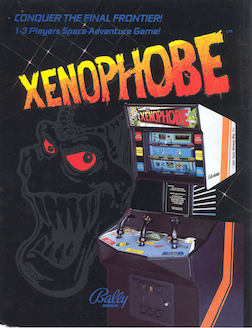
Xenophobe is a video game developed by Bally Midway and released in arcades in 1987. Starbases, moons, ships, and space cities are infested with aliens, and the players have to kill the aliens before each is completely overrun. The screen is split into three horizontally-scrolling windows, one for each of up to three players, yet all players are in the same game world.

Joust is an action game developed by Williams Electronics and released in arcades in 1982. While not the first two-player cooperative video game, Joust's success and polished implementation popularized the concept. Players assume the role of knights armed with lances and mounted on large birds, who must fly around the screen and defeat enemy knights riding buzzards.

Missile Command is a 1980 shoot 'em up arcade video game developed and published by Atari, Inc. and licensed to Sega for Japanese and European releases. It was designed by Dave Theurer, who also designed Atari's vector graphics game Tempest from the same year. The game was released during the Cold War, and the player uses a trackball to defend six cities from intercontinental ballistic missiles by launching anti-ballistic missiles from three bases.

Defender is a horizontally scrolling shooter developed by Williams Electronics in 1980 and released as an arcade video game in 1981. The game is set on either an unnamed planet or city where the player must defeat waves of invading aliens while protecting astronauts. Development was led by Eugene Jarvis, a pinball programmer at Williams; Defender was Jarvis's first video game project and drew inspiration from Space Invaders and Asteroids. Defender was demonstrated in late 1980, before entering production in early 1981. It was distributed in Japan by Taito.
Exidy, Inc. was a developer and manufacturer of coin-operated electro-mechanical and video games which operated from 1973 to 1999. They manufactured many notable titles including Death Race (1976), Circus (1978), Star Fire (1978), Venture (1981), Mouse Trap (1981), Crossbow (1983), and Chiller (1986). They were also the creators of the Exidy Sorcerer (1978) home computer platform.

Stargate is a horizontally scrolling shooter released as an arcade video game in 1981 by Williams Electronics. Created by Eugene Jarvis and Larry DeMar, it is a sequel to Defender which was released earlier in the year. It was the first of only three productions from Vid Kidz, an independent development house formed by Jarvis and DeMar. Some home ports of Stargate were renamed to Defender II for legal reasons.
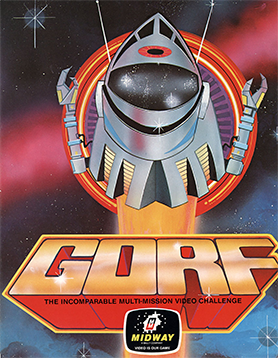
Gorf is an arcade video game released in 1981 by Midway Manufacturing, whose name was advertised as an acronym for "Galactic Orbiting Robot Force". It is a fixed shooter with five distinct levels, the first of which is based on Space Invaders and another on Galaxian. The game makes heavy use of synthesized speech for the Gorfian robot which taunts the player, powered by the Votrax speech chip. Gorf allows the player to buy two additional lives per quarter before starting the game, for a maximum of seven lives.

Xevious is a vertically scrolling shooter arcade video game developed and published by Namco in 1982. It was released in Japan by Namco and in North America by Atari, Inc. Controlling the Solvalou starship, the player attacks Xevious forces before they destroy all of mankind. The Solvalou has two weapons at its disposal: a zapper to destroy flying craft, and a blaster to bomb ground installations and enemies. It runs on the Namco Galaga arcade system.

Robotron: 2084 is a multidirectional shooter developed by Eugene Jarvis and Larry DeMar of Vid Kidz and released in arcades by Williams Electronics in 1982. The game is set in the year 2084 in a fictional world where robots have turned against humans in a cybernetic revolt. The aim is to defeat endless waves of robots, rescue surviving humans, and earn as many points as possible.
The following article is a broad timeline of arcade video games.

Star Raiders II is a space combat simulator released in 1986 for Atari 8-bit computers as a sequel to 1979's Star Raiders, which was the killer app for the system. The game was originally developed as part of a tie-in with the movie The Last Starfighter, which featured an arcade game of the same name as part of its plotline. Versions for the Atari 5200 and the Atari 8-bit computers were developed in 1984, although those were never released. Later the tie-in was dropped, and the game converted into a sequel to Star Raiders by changing a number of gameplay elements. The gameplay remained different from the original Star Raiders.
Blaster is a first-person rail shooter released as an arcade video game by Williams Electronics in 1983. It was developed by Eugene Jarvis and Larry DeMar. A vague sequel to Robotron: 2084, the game is a shoot 'em up set in outer space. The goal is to destroy enemies, avoid obstacles, and rescue astronauts in twenty levels, to reach paradise.
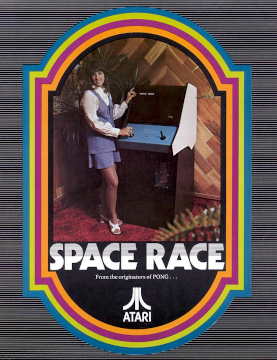
Space Race is an arcade game developed by Atari, Inc. and released on July 16, 1973. It was the second game by the company, after Pong (1972), which marked the beginning of the commercial video game industry along with the Magnavox Odyssey. In the game, two players each control a rocket ship, with the goal of being the first to move their ship from the bottom of the screen to the top. Along the way are asteroids, which the players must avoid. Space Race was the first racing arcade video game and the first game with a goal of crossing the screen while avoiding obstacles.

Starship 1 is a first-person shooter space combat game developed and manufactured for arcades in 1977 by Atari, Inc. The game, which takes great inspiration from the then very popular television series Star Trek, contains the first known Easter egg in any arcade game. The arcade game was distributed in Japan by Namco in 1978, and it was ported to the Atari 2600 as Star Ship.
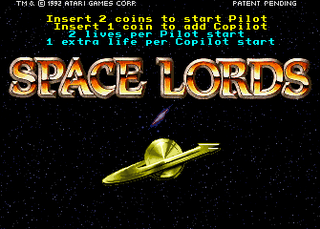
Space Lords is a video game released in arcades by Atari Games in 1992. It is a first-person perspective space combat video game.

Sea Wolf is an arcade video game designed by Dave Nutting and released by Midway in 1976. It is a video game update of an electro-mechanical Midway game, Sea Devil, itself based on Sega's 1966 electro-mechanical arcade submarine simulator Periscope. The game was released in Japan by Taito. In Sea Wolf, the player, piloting an unseen submarine, launches torpedoes vertically in an attempt to sink ships moving horizontally across the screen before time runs out. The screen is viewed through a faux periscope mounted on the cabinet.

Circus is a block breaker arcade game released by Exidy in 1977, and distributed by Taito in Japan. The game is a re-themed variant of Atari's Breakout, where the player controls a seesaw and clown in order to pop all the balloons in the level. The game has been copied and released under different names by numerous other companies in both the United States and Japan.
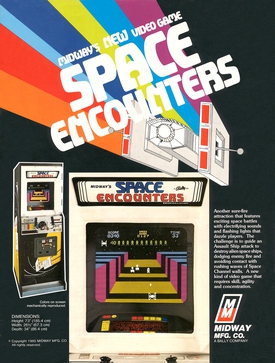
Space Encounters is an arcade video game released by Bally Midway in 1980.. The game recreates the trench flying scene from Star Wars but with the player in a TIE fighter. The player's ship shoots at waves of enemies flying down from the top. The moving background graphics provide the illusion of an isometric 3D view, but the action is in 2D and plays like a fixed shooter.
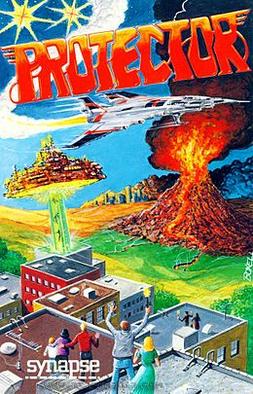
Protector is a 1981 scrolling shooter for Atari 8-bit computers programmed by Mike Potter and distributed first by Crystalware and then Synapse Software. A VIC-20 port was published by HesWare in 1983.

















